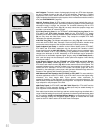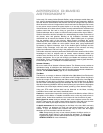
51
Equatorial Alignment
In equatorial (or "polar") Alignment, the telescope is oriented so that the horizontal and
vertical axes of the telescope are lined up with the celestial coordinate system.
In order to equatorial align your telescope, it is essential to have an understanding of how
and where to locate celestial objects as they move across the sky. This section provides a
basic introduction to the terminology of equatorial-aligned astronomy and includes
instructions for finding the celestial pole and for finding objects in the night sky using
Declination and Right Ascension.
Celestial Coordinates
A celestial coordinate system was created that maps an imaginary sphere
surrounding the Earth upon which all stars appear to be placed. This mapping system is
similar to the system of latitude and longitude on Earth surface maps.
In mapping the surface of the Earth, lines of longitude are drawn between the North and
South Poles and lines of latitude are drawn in an East-West direction, parallel to the Earth’s
equator. Similarly, imaginary lines have been drawn to form a latitude and longitude grid for
the celestial sphere. These lines are known as
Right Ascension and Declination.
The celestial map also contains two poles and an equator just like a map of the Earth. The
poles of this coordinate system are defined as those two points where the Earth’s North and
South poles (
i.e., the Earth's axis), if extended to infinity, would cross the celestial sphere.
Thus, the North Celestial Pole (
1, Fig. 42) is that point in the sky where an extension of the
North Pole intersects the celestial sphere. The North Star, Polaris, is located very near the
North Celestial Pole (
1, Fig. 42). The celestial equator (2, Fig. 42) is a projection of the
Earth’s equator onto the celestial sphere.
So just as an object's position on the Earth’s surface can be located by its latitude and
longitude, celestial objects may also be located using Right Ascension and Declination.
For
example
: You could locate Los Angeles, California, by its latitude (+34°) and longitude
(118°). Similarly, you could locate the Ring Nebula (M57) by its Right Ascension (18hr) and
its Declination (+33°).
■ Right Ascension (R.A.): This celestial version of longitude is measured in units of
hours (hr), minutes (min) and seconds (sec) on a 24-hour "clock" (similar to how
Earth's time zones are determined by longitude lines). The "zero" line was arbitrarily
chosen to pass through the constellation Pegasus, a sort of cosmic Greenwich merid-
ian. R.A. coordinates range from 0hr 0min 0sec to 23hr 59min 59sec. There are 24
primary lines of R.A., located at 15-degree intervals along the celestial equator.
Objects located further and further East of the zero R.A. grid line (0hr 0min 0sec) carry
higher R.A. coordinates.
■ Declination (Dec.): This celestial version of latitude is measured in degrees,
arc-minutes and arc-seconds (
e.g., 15° 27' 33"). Dec. locations North of the celestial
equator are indicated with a plus (+) sign (e.g., the Dec. of the North celestial pole is
+90°). Dec. locations South of the celestial equator are indicated with a minus (–) sign
(e.g., the Dec. of the South celestial pole is –90°). Any point on the celestial equator
(such as the the constellations of Orion, Virgo and Aquarius) is said to have a
Declination of zero, shown as 0° 0' 0."
Polar Mounting your Telescope with the #884 Deluxe Field Tripod
As the Earth rotates on its axis, astronomical objects appear to move across the sky in an
arc. This apparent motion is not obvious to the unaided eye, but when viewed through a
telescope such as an ETX, this motion is rapid indeed. If the motor drive has not been
engaged, celestial objects viewed in the telescope eyepiece drift
entirely out of the field of view in 15 to 60 seconds, depending on the magnification
employed.
However, by mounting your telescope and turning on the motor drive, you can
counteract the drift of objects in the eyepiece. The two basic types of mounting are:
altazimuth (alt/az) and equatorial. For many ETX owners, it will not be necessary to
equatorially mount the telescope; alt/az mounting will suffice. The Autostar Controller allows
the telescope to be mounted in the altazimuth (alt/az) mode for most
observing purposes. See
EASY (TWO-STAR) ALIGN, page 19, for more information.
14
15
16
17
18
19
20
21
22
23
0
1
12
11
10
9
8
7
5
6
4
3
2
13
Earth’s
Rotation
0 Dec.
South
Celestial
Pole
Right Ascension
Star
Celestial
Equator
-90 Dec.
+90 Dec.
North
Celestial
Pole
(Vicinity
of Polaris)
D
e
c
l
i
n
a
t
i
o
n
1
2
Fig. 42: Celestial Sphere.
APPENDIX A: EQUATORIAL
(POLAR) ALIGNMENT
Important Note:
The "Telescope:Mount"
option of the Setup menu is
set to "Alt/Az" as the default
mount by the factory.If the
telescope is equatorially
mounted, you must choose
the "Polar" option from the
Autostar "Telescope: Mount"
menu.


















